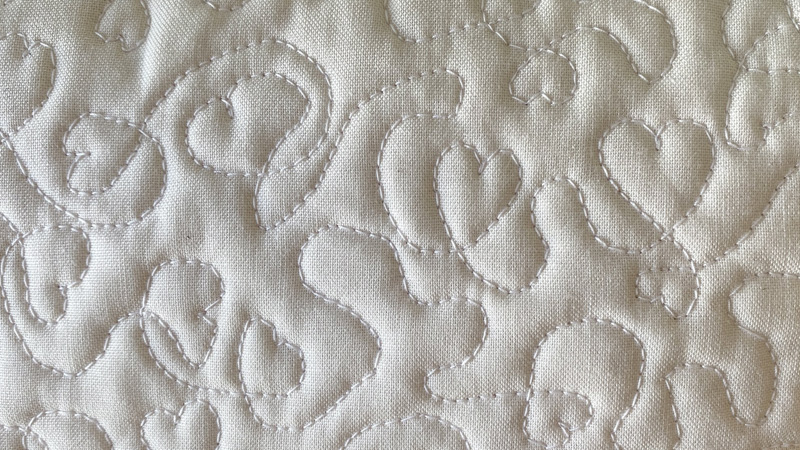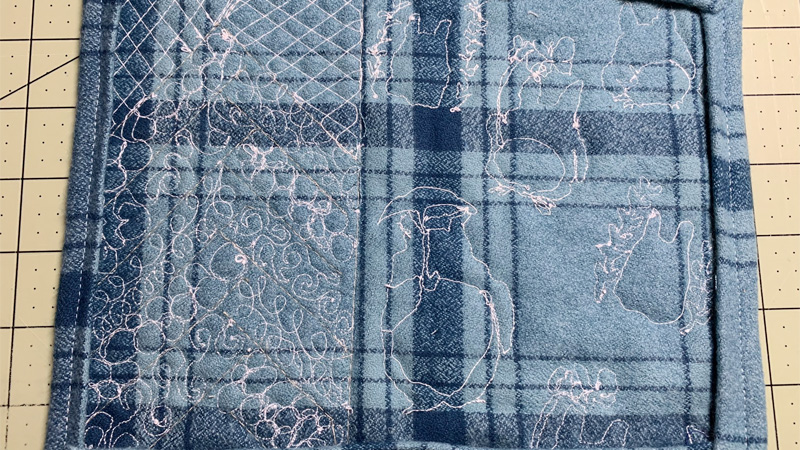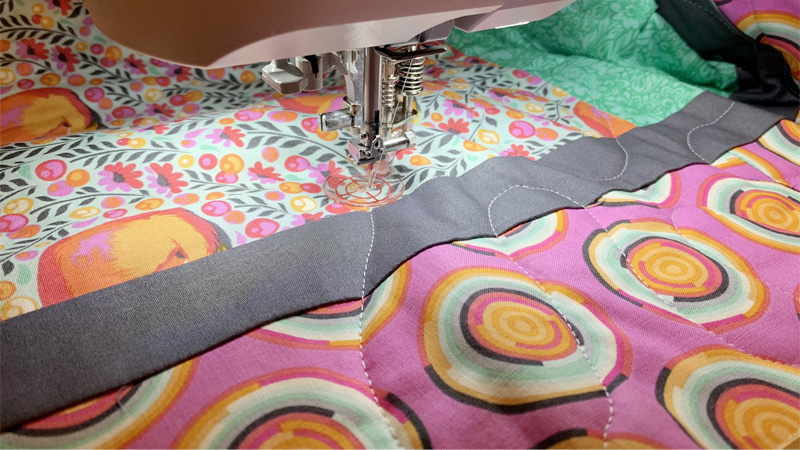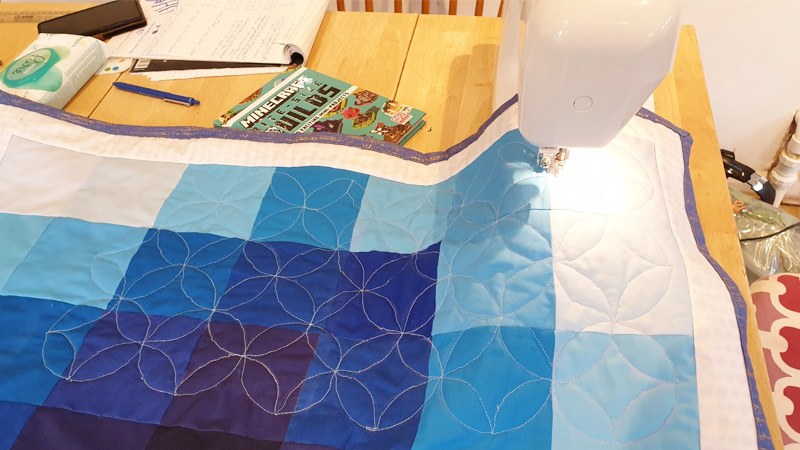Free motion quilting is a captivating and artistic technique that adds a unique dimension to the world of quilting. Unlike traditional quilting, where stitches are guided by the sewing machine’s feed dogs, free-motion quilting empowers the quilter with the freedom to move the fabric in any direction while stitching.
This technique opens a realm of creative possibilities, enabling quilters to craft intricate and personalized designs on their quilts.
Whether it’s adding decorative motifs, securing quilt layers, or creating custom patterns, free-motion quilting has become a celebrated method for both functionality and artistic expression.
It requires practice and skill to achieve smooth and even stitches, making each quilt a testament to the quilter’s craftsmanship. In this exploration of free motion quilting, we will delve into what is free motion quilting, its applications, and the creative potential it offers to quilting enthusiasts.

What Is Free Motion Quilting?
Free motion quilting is a versatile and artistic quilting technique that allows sewers to create intricate and customized designs on the quilt top by moving the fabric freely under the sewing machine’s needle,
unlike traditional quilting, where the machine’s feed dogs guide the fabric, free motion quilting involves lowering or covering the feed dogs, enabling the quilter to control the fabric’s movement entirely.
This hands-on approach offers creative freedom, making it possible to stitch various motifs, patterns, and even freehand drawings onto the quilt.
Free motion quilting requires practice to achieve smooth and even stitches, but it allows for endless possibilities in terms of design, making each quilt a unique and personalized work of art.
This technique has gained popularity among quilters for its ability to add texture, depth, and visual interest to quilts, enhancing their overall aesthetic appeal.
Here are some interesting functions of free-motion quilting:
Decorative Stitching
Free-motion quilting serves as a versatile method for adding decorative stitching to quilts and fabric projects. Quilters can create intricate patterns, motifs, or even personalized designs that enhance the visual appeal of their work.
This function allows for creative expression and customization, making each quilt a unique piece of art.
Securing Quilt Layers
One of the primary functions of free-motion quilting is to secure the quilt top, batting, and backing layers together. By stitching through all layers, quilters prevent shifting or bunching, ensuring the quilt remains intact over time.
This function is essential for both the structural integrity and longevity of the quilt.
Texture and Dimension
Free motion quilting adds texture and dimension to quilts. Quilters can experiment with different quilting designs to create raised or recessed areas, providing a tactile quality that enhances the overall quilting experience.
These textured surfaces can mimic the appearance of various elements, such as water ripples or tree bark.
Quilted Outlines

Free motion quilting allows for the creation of quilted outlines around appliqué or embroidered designs.
These outlines serve to accentuate and define the shapes, adding visual interest and a polished finish to the quilt. This function is particularly common in art quilts and intricate projects.
Embellishments and Embroidery
Quilters can use free-motion quilting to embellish their projects with additional details, such as floral motifs, vines, or lettering.
This function enables them to infuse their quilts with thematic or storytelling elements, making the quilt not only visually appealing but also meaningful.
Customized Fill Patterns
Quilters can employ free-motion quilting to fill empty spaces within their quilt blocks or backgrounds with customized fill patterns.
These files can range from simple stippling and meandering to more complex designs like feathers or swirls. This function adds depth and complexity to the quilt’s overall design.
Artistic Expression
Beyond its practical functions, free-motion quilting is a form of artistic expression. It allows quilters to explore their creativity, experiment with various threads, and develop their quilting style.
Whether through intricate motifs or freehand designs, this function fosters a sense of individuality and artistry in quilting.
Free-motion quilting serves a multitude of functions in quilting, ranging from securing quilt layers to adding texture, dimension, and artistic flair to quilts and fabric projects.
It is a versatile and essential technique for quilters seeking to create visually captivating and structurally sound quilts.
Where Do You Start Free Motion On A Quilt?

Starting free-motion quilting on a quilt can be a crucial decision as it determines the overall quilting pattern and symmetry.
Here are the common places to start free-motion quilting:
Center Block
Beginning free-motion quilting in the center block of the quilt is a classic choice. It allows you to create a focal point and radiate your quilting design outward.
Starting here often results in balanced and symmetrical quilting patterns that flow naturally from the center to the edges.
Outer Border
Commencing the free-motion quilting in the outer border of the quilt can provide a sense of containment and framing for your design. It’s a practical choice when you want to establish a strong border motif or frame the quilt’s central elements.
Corners
Starting in the corners of the quilt can be aesthetically pleasing, especially when you have corner-specific designs or motifs in mind. This approach can help you anchor your quilting pattern and ensure that it flows seamlessly around the quilt’s edges.
Sashing
If your quilt has sashing strips between blocks, starting the free-motion quilting in the sashing can create a structured and organized appearance. You can use this space to establish a consistent border pattern or transition into different block designs.
Block Centers
Initiating the quilting in the center of individual quilt blocks is ideal when you have distinct block-specific motifs or want to emphasize the unique features of each block.
This approach highlights the individuality of the blocks within your quilt.
Basting Line
Some quilters prefer to start near a basting line or seam. This allows for an inconspicuous start that can be easily hidden or incorporated into the overall quilting pattern.
It also minimizes the risk of creating a noticeable knot or thread tail at the beginning.
Random Placement
For a more organic and freeform look, you can begin free-motion quilting at a random point on the quilt’s surface. This approach embraces spontaneity and can lead to unique and unpredictable quilting designs.
However, it may require more planning to ensure the quilting covers the entire quilt evenly.
Ultimately, the choice of where to start free motion quilting depends on your design goals and the overall aesthetic you want to achieve.
Consider the quilt’s layout, your desired quilting pattern, and any specific motifs or elements you want to highlight when determining the best starting point for your project.
How To Do Free Motion Quilting On A Regular Sewing Machine?

Free motion quilting on a regular sewing machine can be a rewarding and creative endeavor.
Here are the simple methods to help you get started:
Set Up Your Machine
Begin by attaching a free-motion or darning foot to your sewing machine. This specialized foot is designed to allow you to move the fabric freely in all directions.
Ensure your machine is threaded with the desired thread color and that you have an appropriate needle installed for your fabric.
Lower the Feed Dogs
Most sewing machines have a switch or lever to lower the feed dogs, which are responsible for moving the fabric forward. In free-motion quilting, you want to disable this function so that you can control the fabric’s movement entirely.
Refer to your machine’s manual for instructions on how to lower the feed dogs.
Select the Right Stitch
Set your machine to the straight stitch or a simple zigzag stitch with a width of zero. This eliminates any side-to-side movement of the needle, allowing you to control the stitch direction entirely with your hand movements.
Practice Scrap Fabric
Before working on your actual quilting project, practice free-motion quilting on a scrap piece of fabric. This will help you get comfortable with the feel of moving the fabric while sewing and allow you to fine-tune your technique.
Use a Quilting Hoop or Frame
Consider using a quilting hoop or frame to help keep your fabric taut and prevent wrinkles or puckering. This can make free-motion quilting more manageable, especially for larger quilts.
Plan Your Design
Decide on the quilting design you want to create. Start with simpler patterns like meandering or stippling if you’re new to free-motion quilting. As you gain confidence, you can explore more intricate motifs and designs.
Begin Quilting
With your practice and design plan in mind, start quilting on your project. Hold the fabric lightly but securely with both hands and use slow, steady movements to guide the fabric under the needle.
As you sew, focus on maintaining even stitch lengths and consistent tension.
Remember that free motion quilting takes practice to master. Don’t be discouraged if your initial attempts are not perfect; it’s all part of the learning process.
With patience and perseverance, you’ll improve your skills and be able to create beautiful and intricate quilting designs on your regular sewing machine.
FAQs
What is free motion quilting?
Free motion quilting is a quilting technique that involves sewing intricate designs or patterns on a quilt without the use of the sewing machine’s feed dogs to guide the fabric.
Quilters manually move the fabric under the needle to create unique stitching patterns, ranging from simple meandering lines to complex motifs and designs.
What type of sewing machine do I need for free-motion quilting?
While specialized quilting machines are available, you can perform free-motion quilting on most regular sewing machines. You’ll need a free-motion or darning foot to enable fabric movement and the ability to lower the machine’s feed dogs to disengage their automatic feeding function.
Is free motion quilting difficult to learn?
Free motion quilting can be challenging for beginners, but it becomes more manageable with practice. Start with basic patterns and gradually work your way up to more complex designs. Regular practice on scrap fabric helps improve control and stitch consistency.
What types of quilting designs can I create with free-motion quilting?
The possibilities are endless! Quilters can create stippling, meandering swirls, feathers, flowers, and custom motifs, among many other designs.
Your imagination is the limit, and free motion quilting allows for personalization and creativity in your quilted projects.
Do I need to mark my quilt before free-motion quilting?
Marking is optional but can be helpful for intricate or symmetrical designs. Water-soluble or air-erasable fabric markers allow you to draw guidelines on your quilt top that will disappear over time.
However, some quilters prefer to quilt freehand without marking, relying on their skills and creativity to guide the stitching.
Conclusion
Free motion quilting, with its fusion of artistry and practicality, has revolutionized the quilting world, allowing quilters to transform fabric into exquisite works of craftsmanship.
The freedom to create intricate patterns, secure quilt layers, and add decorative elements has made free-motion quilting an essential skill for those passionate about this textile art form.
As quilters develop their technique and confidence, they unlock the potential to infuse their quilts with personalized designs, thematic motifs, and captivating textures.
It’s a journey that demands practice, patience, and creativity, but the results are nothing short of awe-inspiring. Each quilt becomes a canvas for expression, a testament to skill, and a cherished heirloom.
Free motion quilting stands as a testament to the enduring artistry of quilting and continues to inspire generations of quilters to embark on their own creative quilting odyssey.
Meta:
Leave a Reply